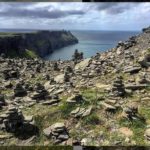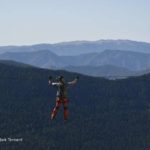The risk of avalanches has recently hit the headlines following a tragedy at the ski resort of Tignes in the French Alps. The avalanche cost the lives of four people including the ski instructor.
Note: My article seeks only to see what can be learned from this tragedy. Nothing in this article should be interpreted as criticism of the instructor involved. We all may do things differently in hindsight. My sincere condolences go to the families of all those involved.
Where the avalanche took place
The avalanche took place off-piste (definition?) below the Pointe du Lavachet (2652m). The slope where they were avalanched is known as the Lavachet Wall with a slope angle c. 38 degrees. The slope is at an altitude of between 2141 and 2588m. The slope faces North-West. At the bottom of the slope a large man-made ?berm? earthern / rock ridge protects part of the resort from avalanches coming from this slope. [in photo]
The Avalanche Forecast for Monday, 13 February 2017
The Avalanche forecast for this Monday issued by Meteo France for the ?Massif Haute Tarentaise? was written at 16h00 the previous afternoon. The forecast gives the following details:
Avalanche Risk: Category 3 – ?Risque Marque? (?Considerable? in English). [This risk level is extremely common throughout the winter. The European Avalanche scale runs from 1 ? 5 however 3 should never be considered to be ?medium? in terms of risk].
Compass: it identifies slopes from South, through West, to North as being most at risk.
It talks about natural avalanche releases caused by a rise in temperature. It predicts recent ?slabs? at altitude being released by skiers.
Snowpack Stability
The forecast identifies that the Foehn will transport snow and cause new accumulations above 1900 to 2000m. Slab avalanches have been noted from 2500m. Overall the areas the most at risk are concentrated along the Italian frontier [ very close to Tignes] on west-facing slopes and slabs up to 40cm thick may be involved. These recent slabs may release due to the passage of a single skier where the slope steepens.
The current warming up is to be watched out for. A partial moistening of the snow pack is possible and may reach fragile layers and cause natural avalanche releases on steep slopes [ considered to be above 35 deg.] Locally spring-like conditions and times to watch out for. [Just because a slope has already skied doesn’t mean it’s safe.]
Known facts
- The group were on snowboards and had completed the same run earlier in the morning. One of the group dropped their snowboard and didn’t continue.
- The group were traversing, on foot, when the avalanche released.
- The ski instructor was 59 years old and had been working in the area for the last 30 years.
- All members of the group were equipped with avalanche transceivers, probes and shovels. [Standard equipment for going off-piste].
My thoughts …
The Lavachet Wall fits into the type of slope in terms of aspect, altitude and steepness identified in the avalanche forecast.
The fact that the slope didn’t release during the first run may be due to it being cooler than later in the morning. It may also be due to not ?hitting? critical spots on the slope where the collapse of the weak layer would be induced and propagated.
The decision to ski the slope may have been influenced by the instructors undoubtedly extremely good knowledge of the area. ?Familiarity? is considered to be one of several heuristic traps found to be influential in avalanche incidents.
The ?berm? at the bottom of the slope created a ?terrain trap? causing the avalanche debris to accumulate to depths reportedly up to 8m. If the slope had become gradually less steep the depth of burial may have been significantly less increasingly significantly the chances of survival. Statistics from France show that typical burial depths are between 1m and 1.5m.
The group was on foot at the time the avalanche released. Although not certain it may suggest that they were relatively close to one another on the slope. This would have concentrated their weight on the slope increasing the chances of triggering. Their feet would also penetrate deeper into the snowpack with an increased likelihood affecting a fragile layer. Being close together increased the chances of them all being taken in an avalanche. You should be sufficiently spaced out to avoid this and to avoid over-loading the slope. If available, use ?islands of safety? and move one at a time.
Key Points
- Read the avalanche bulletin thoroughly. Don’t just skim read it.
- Ensure that where there is a risk of avalanche that you are well spaced out and use ?islands of safety?.
- Be very aware of potential ?terrain traps?.


